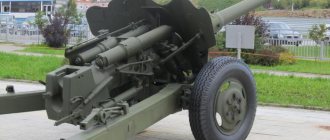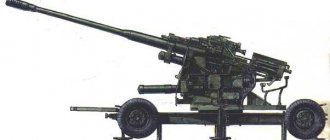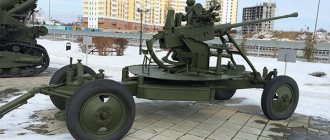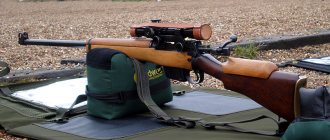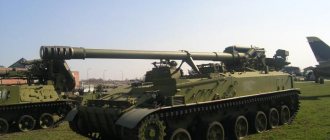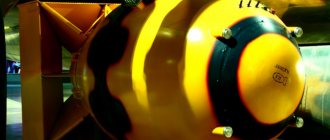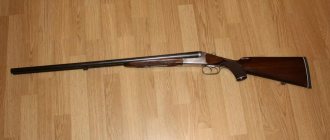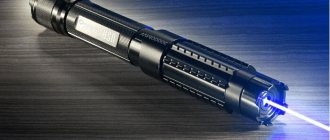Notes
- Chebotarev S.
I. artofwar.ru (March 12, 2012). Retrieved May 24, 2016.
Beshkarev A.I. artofwar.ru (May 5, 2016). Retrieved May 24, 2016.- Antipov A.V.
Lev Rokhlin: The life and death of a general.. - M.: Eksmo-Press. — 418 p. — ISBN 5-04-001676-X. - . OSCE (6 May 2016). Retrieved May 22, 2016.
- . “Motovilikha Plants” OJSC
(2013). Retrieved August 19, 2022. - The Military Balance 2016. - P. 178.
- The Military Balance 2016. - P. 182.
- The Military Balance 2016. - P. 184.
- The Military Balance 2016. - P. 188.
- The Military Balance 2022. - P. 210.
- . Press service of the Eastern Military District
(05/23/2017). Retrieved July 24, 2022. - The Military Balance 2016. - P. 194.
- The Military Balance 2016. - P. 203.
- ↑ The Military Balance 2016. - P. 205.
- The Military Balance 2016. - P. 208.
- ↑
- The Military Balance 2012. - P. 255.
- Ruzaev S.V.
Artillery systems from the collection of the UMMC Museum of Military Equipment. - Ekaterinburg: Uralsky Rabochiy, 2022. - 80 p. — 1000 copies. — ISBN 978-5-85383-687-7.
TTX
- Caliber, mm
: 152 - Maximum firing range, km
: OFS - 24.7; OFS with gas generator - 28.5 - Minimum firing range, km
: 6,5 - Rate of fire, rds/min.
: 7 - Initial speed of OFS at charge temperature 15 °C, m\s
: 810 - Pressure in the head at a barrel elevation angle of 0° MPa (kgf/cm2)
: 9,5±0,5 (95±5) - Elevation angle, degrees.
: −3…+70 - Horizontal guidance angle, degrees.
: −27…+28 - Firing accuracy
: By range, Vd/H max: 1/363 - On the side, Wb, m: 11
: 43,56
: 12,05
: 7000
: 2599
: 170
: 12700
: 2500
: 2950
: 8130
: 6184
: 48
: 7
: 1330
: 1000
: 16
: 17,5
: 10,5
: 5,5±0,25 (55±2,5)
: 1,0
: 400
: 2150
: 2—2,5
: 60
: 8
Device and characteristics
In towed position.
The artillery part of the 2A65 or “Msta-B” howitzer has a design similar to the artillery part of the 152-mm self-propelled howitzer 2S19 or “Msta-S” (GRAU Index 2A64) and differs only in the presence of an ejector in the 2A64 for removing powder gases from the barrel after a shot.
The towed howitzer 2A65 is made according to the classic design of an artillery gun. It has a 53-caliber long monoblock barrel equipped with a three-chamber cast muzzle brake and a semi-automatic vertical wedge bolt, hydropneumatic recoil devices mounted above the barrel (liquid-cooled recoil brake and knurler), an upper machine with a shield cover to protect the crew and howitzer mechanisms from bullets and small fragments, lifting (two-speed, sector type), rotary (two-speed, screw) and balancing mechanisms, as well as a lower machine with two box-section frames and a two-wheeled chassis. A special pallet is mounted on the lower machine of the carriage, onto which the gun is lowered using a hydraulic jack when transferring it from the traveling position to the combat position. At the ends of the box frames, auxiliary metal rollers are mounted, with the help of which the gun can be rotated for firing in any desired position (without changing the position of the frames, the angle is 52°). In the vertical plane, the lifting mechanism of the upper machine ensures that the gun is aimed at the target in an angle range from −3.5° to +70°.
To increase the rate of fire and reduce crew fatigue, the gun is equipped with two throw-type spring rammers for delivering shells and charges.
When the gun is moved to the stowed position, the pallet is raised and attached to the barrel and cradle, the frames are shifted and connected to the towbar of the tractor. The standard means of transporting the howitzer is the Ural 4320 army truck with a 6x6 wheel arrangement or the more powerful KamAZ 63501AT 8x8. The sprung wheel travel of the gun allows it to be towed on the highway at speeds of up to 80 km/h, and on rough terrain - up to 20 km/h.
Calculation - 8 people.
Description[edit]
Br-2, breech and controls.
Br-2, highway.
The Br-2 had a long - 47.2 caliber - barrel of a rodless design with an intermittent screw breech. The recoil system with variable recoil length consisted of a hydraulic recoil buffer and a hydropneumatic recuperator. The gun used ammunition with a loading bag. A special crane was used to assist with loading.
The tracked single carriage was almost the same as that of the 203 mm M1931 (B-4) howitzer and the 280 mm M1939 (Br-5) mortar. It included a push-type balancing mechanism. The carriage allowed the weapon to be transported over short distances at a speed of 5–8 km/h. For long distances, the barrel was removed from the carriage and transported separately on a special cart. At the same time, it took from 45 minutes to two hours to prepare the weapon for battle.
Several types of carts were used to transport barrels. The 1937 guns received the Br-6 bogie. Wheeled Br-10 (11.1 tons with barrel) and tracked Br-29 (13.42 tons with barrel) were also used. In the test report dated August 7, 1938, both were found unsatisfactory; the first due to poor cross-country ability, the second due to excess weight. [1]
Voroshilovets tracked tractors were used to transport wagons
.
Comintern
tracked tractors were used to tow artillery carts .
Notes[edit]
- The Military Balance 2016. - P. 180.
- The Military Balance 2016. - P. 178.
- The Military Balance 2016. - P. 182.
- The Military Balance 2016. - P. 184.
- ↑
- The Military Balance 2012. - P. 255.
- The Military Balance 2016. - P. 188.
- The Military Balance 2016. - P. 190.
- The Military Balance 2016. - P. 194.
- The Military Balance 2016. - P. 203.
- ↑ The Military Balance 2016. - P. 205.
- The Military Balance 2016. - P. 208.
- Privacy Policy
- Wikipedia Description
- Denial of responsibility
Copy of Wikipedia
on a technological basis
WikiKnowledge project
- Create an account
- To come in
Wikipedia
- Home page
- Fresh edits
- Random article
- Community Portal
- Wikipedia Description
Make a donation
Modernization
At the end of the 60s, another change in generations of weapons began in the USSR. New aircraft and tanks were created, small arms were modernized, and the fleet was improved. Similar changes did not spare artillery.
Then, in service with the “gods of war”, that’s what artillerymen were called since the First World War, the most popular was the M-46 field gun, which over time began to cause more and more criticism. Its power no longer met world standards, the 130 mm cartridge was no longer the most combat-ready, and its clumsy design was causing more and more trouble in a modern army where mobility was valued most.
Also, the impossibility of transporting the guns with conventional vehicles and tractors did not help, which was already a complete waste of money and a complete technical backwardness from competitors. Therefore, at the end of the 60s, it was decided to begin work on the creation of a fundamentally new artillery weapon, which could not only replace the M-46, but also set new standards for such weapons.
Weapon of victory: the best gun of the Great Patriotic War ZIS-3
Sergey Varshavchik, for RIA Novosti
Exactly 75 years ago, on February 12, 1942, by decree of the State Defense Committee of the USSR, the most popular weapon of the Second World War, the 76-mm ZIS-3 divisional gun, was adopted into service by the Red Army, which became a threat to enemy armored forces and infantry.
The main thing is to knock out German tanks
Indeed, the main burden of the fight against the striking force of the Wehrmacht, the Panzerfaffe, fell on the shoulders of the artillerymen from the very first days of the war. In 1941, the most popular Soviet anti-tank weapon was the semi-automatic 45-mm gun of the 1937 model.
It confidently hit the 50-millimeter armor of enemy vehicles from 500 meters; due to its light weight and small size, it was maneuverable and unnoticeable to enemy tank crews.
At the same time, the very first battles showed that its crew was very vulnerable both from mortar fire and from enemy artillery shells. It is no coincidence that the soldiers awarded the forty-five with the nicknames “Farewell, Motherland!” and “Until the first shot.”
The 57 mm anti-tank gun of the 1941 model had problems of a different nature. The gun, which was manufactured at the Gorky Artillery Plant named after Stalin and received the name ZIS-2, was recognized as overly powerful due to excessive penetration. It was very expensive to manufacture, and therefore it was discontinued.
Later, when the Germans had heavy tanks and self-propelled guns, production of the ZIS-2 was resumed. In this case, the gun was usually installed on tanks and self-propelled guns.
Innovative method of designer Grabin
Divisional and anti-tank artillery needed something cheaper and at the same time technologically advanced. In addition, more than 36 thousand guns were lost in the first year of the war, and they had to be quickly replaced.
Structurally, the ZIS-3 was a continuation of the ZIS-2. Designer Vasily Grabin began working on it even before the war. By that time, 42-year-old Grabin had behind him the artillery department of the Dzerzhinsky Military Technical Academy and many years of work at artillery factories, where he was developing promising models of barrel artillery.
Back in the 30s, Grabin developed at the Stalin plant an ergonomic method for high-speed design of cannon systems, which made it possible to create new types of guns in a matter of months, and sometimes weeks. The advanced method helped designers and technologists produce guns with great savings in labor, energy and metal.
Faster, cheaper, easier
When designing the 76-mm division, Grabin immediately set his sights on its mass production. To achieve this, the number of technological operations was reduced - in particular, due to the high-quality casting of large parts, unification and continuous production of components were introduced. The number of parts was reduced from 2080 to 1306. All this made it possible to produce a new weapon much faster and cheaper, without losing quality.
The recoil force when firing on the ZIS-3 was compensated by 30% by the muzzle brake; an important drawback of the previous model was eliminated in the form of placement of aiming handles on opposite sides of the gun barrel. The latter allowed the gun crew to perform only their direct functions in battle. In addition, the gun was 420 kilograms lighter than the previous model and had greater ground clearance.
Operators
Hyacinth cartridges.
- Azerbaijan Azerbaijan - 18 2A36, as of 2016
- Armenia Armenia - 26 2A36, as of 2016
- Belarus Belarus - 48 2A36, as of 2016. According to other sources, it is not in service.
- Georgia Georgia - 3 2A36, as of 2016
- Moldova Moldova - 21 2A36, as of 2016
- Russia Russia: 1,100 2A36 in storage, as of 2022 Ground Forces - some in service with the 68th Army Corps
- Coastal troops - 50 2A36, as of 2016
- Ground forces - 180 2A36, as of 2016
Former operators
- USSR USSR - passed to the states formed after the collapse
- Iraq Iraq - 180 2A36 delivered from the USSR between 1988 and 1988
- Kazakhstan Kazakhstan - 180 2A36, as of 2012
- Finland Finland - 24 2A36 delivered from the USSR in 1989, used under the designation K-89
Organization and maintenance[edit]
Br-2 in the Museum of the Heroic Defense and Liberation of Sevastopol.
Since June 1941, Br-2 guns entered service with the heavy artillery regiment of the reserve of the High Command. The regiment consisted of four divisions, each with three two-gun batteries, 24 in total. There were also two independent two-gun batteries. After the start of the German-Soviet war, the gun was used by separate six-gun battalions. The organization was later changed again to super-heavy artillery regiments of four two-gun batteries, a total of six Br-2s and two 210 mm Model 1939 (Br-17) guns. By May 1945, there were four such regiments in the Red Army.
Br-2 (or possibly B-30) took part in the Winter War against Finland, one unit was lost. [2] As of June 1941, the Red Army had 37 or 38 [3] guns, of which 24 were in the aforementioned heavy artillery regiment and another four in two separate batteries. These batteries were transferred to the Arkhangelsk Military District for use as coastal artillery. [4] The remaining guns, mostly early models with fine rifling and experimental models, remained in warehouses and training grounds. There is only fragmentary information about the actual combat use of the Br-2. Some sources mention guns used in the Battle of Kursk; [5]The 8th Guards Army used them in the Battle of Seelow Heights. [6] By the end of the war there were still 28 guns in the High Command reserve, so it is clear that none were lost.
The modernized Br-2M remained in service until at least the 1970s.
Surviving exhibits can be seen in the Central Museum of the Armed Forces (Moscow), the Artillery Museum (St. Petersburg) and on Sapun Mountain (Sevastopol).
Modifications of the Br-2 gun
– Br-2 with a bonded barrel - a prototype.
– Br-2 with a finely rifled barrel (GAU index - 52-P-550) - at least 7 pieces were produced. in 1936-1937.
– Br-2 with a 162 mm caliber barrel is a prototype.
– Br-2 with deep rifled barrel (GAU index – 52-P-551) – 27 units produced. in 1939-1940.
– Br-21 is an experimental gun with a caliber of 180 mm.
– Br-2M - Br-2 barrel group on a new wheeled carriage, in service since 1955.
– D-4 - barrel with Br-2 ballistics on a modified carriage of the ML-20 howitzer-gun. Prototype.
Personnel of one of the batteries of the 73rd Corps Artillery Regiment after being awarded at the 152-mm 1935 Br-2 guns
Development and production[edit]
B-10[edit]
Work on a long-range 152-mm gun for the reserve of the High Command began in 1929, when the technical specifications for such a gun were received from the Artillery Directorate in St. Petersburg. [1] The project received the factory index B-10
. The first barrel was manufactured in April 1932; it was sent for testing even before the carriage of its unusual tracked design was ready. Development and testing of the B-10 continued until 1935; A number of problems were identified, including slow ascent, low rate of fire and short service life. As a result, the pistol was not accepted for service. The two manufactured barrels were experimentally modified to fire pre-rifled projectiles and polygonal projectiles respectively. The experiments did not yield any practical results. An attempt to increase the lifting speed using an electric motor failed to achieve a smooth lift. The USSR Navy briefly questioned the adoption of a derivative weapon as a coastal gun, in towed or self-propelled variants, the latter based on the T-28 medium tank chassis. Only the towed version of the B-25 reached factory testing; it was eventually canceled due to design flaws and the Army's decision not to field the B-10. [1]
B-30 and Br-2 [edit]
Br-2, rear view.
In the early 1930s, the Ordnance Department commissioned the development of a "heavy artillery troika", consisting of a 152 mm gun, a 203 mm howitzer and a 280 mm mortar using the same carriage. The development was also entrusted to Stalingrad. Projects for the 152 mm gun were called B-30
(sometimes designated as
B-10-2-30
) and
Br-2
, respectively. Both were connected by a barrel, ballistically identical to that of the B-10, to the tracked carriage of the M1931 (B-4) 203 mm howitzer.
At the end of 1936, he delivered an experimental series of six copies. Several longer (55 caliber) barrels and a number of barrels with deeper rifling were produced. B-30 barrels were also used for extremely unsuccessful experiments with pre-rifled projectiles and variable depth rifling "Ansaldo system".
In general, the Br-2 was similar to the competing design, but had a different barrel design (assembled and free case), a slightly different bolt and balancing mechanism.
Despite the test results in favor of the B-30, the Artillery Directorate decided to adopt the Br-2. The reasons for the decision are not clear. However, in production copies it was decided to switch to a barrel design with a free tube, making the pistol somewhat more similar to the B-30.
Improved options[edit]
Although the Br-2 was accepted into service, it was obvious that the gun had significant shortcomings. One of the problems was the very short barrel life: it took about 100 shots to reduce the muzzle velocity by 4%. In an attempt to solve this problem, an experimental model was made with a longer (55 caliber) barrel; another experimental barrel had a smaller chamber and deeper rifling. Ultimately, preference was given to the latter solution, and from 1938 the deep-rifled version replaced the original barrel in production. It was claimed that the new version had a fivefold increase in service life. However, the life of the new barrel was measured by a different criterion (10% reduction in muzzle velocity), so the actual improvement was likely much less. [1]
Another drawback of the gun was low mobility, aggravated by separate transportation of the barrel. Attempts to improve the tracked carriage (for example, the experimental T-117, tested in 1939) were ultimately unsuccessful. In 1938, the Artillery Directorate issued technical specifications for the wheeled carriage for the Br-2 and the 203 mm M1931 (B-4) howitzer. Work on the project was carried out by the design bureau of plant No. 1. 172
(Perm), director F.F. Petrov. Since the OKB was busy with other tasks, the development of a new carriage - the factory index M-50 - progressed slowly;
it never progressed beyond the design stage and was canceled after the outbreak of the German-Soviet War. An improved Br-15 wheeled trolley for transporting barrels was considered in 1940, but was not put into service because it could not improve the mobility of the carriage. Only in 1955 was the Br-2 version developed, designated Br-2M,
which had a wheeled carriage and did not require separate transportation.
The Br-2 was also used in a number of unsuccessful experiments to eject sub-caliber rounds to increase firing range. These included experiments carried out in 1940 with a 162mm barrel firing 162/100mm shells. During the experiments, the barrel was damaged; In addition, the gun had unsatisfactory ballistics and loading problems. Firing 152/107 mm caliber shells did not significantly increase the range.
Br-19 [edit]
The Br-19 was an experimental unit that combined elements of the late-production Br-2 (bolt, deep-rifled barrel) with elements of the B-30. The gun was tested in 1939; it turned out to be better than the Br-2 and was recommended for production, which, however, never began. [1]
Br-21 [edit]
The Br-21 was an experimental 180 mm gun, developed privately at the Barrikadi factory by mating a Br-2 barrel, bored to 180 mm caliber, with a B-4 carriage. The gun entered testing on December 20, 1939. The gun turned out to be more powerful and more accurate than the Br-2, but was never put into service due to the need to produce new ammunition. [1]
Production[edit]
Br-2 was produced from 1936 or from 1937 to 1940. At least 37 pieces were made. Early examples had barrels with the original "shallow" rifling (at least seven, built in 1936-37), while late production examples had barrels with the newer "deep" rifling (27 in 1939-40).
Notes
- Interview with chief designer V.A. Kukis // Ural military news. - 2012. - No. 37-38 (September).
- . “Motovilikha Plants” OJSC
(2013). Retrieved August 19, 2022. - . Military information agency of the Armed Forces of the Republic of Belarus “Vayar”
. Retrieved August 19, 2022. - The Military Balance 2016. - P. 182.
- The Military Balance 2016. - P. 183.
- The Military Balance 2016. - P. 184.
- The Military Balance 2016. - P. 185.
- The Military Balance 2016. - P. 190.
- The Military Balance 2016. - P. 194.
- The Military Balance 2016. - P. 203.
- The Military Balance 2016. - P. 205.
- . Air Defense Bulletin. Retrieved December 7, 2015.
- The Military Balance 2016. - P. 491.
- . TASS (February 25, 2015). Retrieved May 22, 2016.
- . Lenta.ru (July 30, 2014). Retrieved December 7, 2015.
- Dmitry Litovkin.
. Glance (August 1, 2014). Retrieved December 7, 2015. - (English). CNN (February 17, 2016). Retrieved May 22, 2016.
2A36 "Gyacinth-B" - towed gun 152 mm caliber
In connection with the gradual removal from service of the 130-mm M-46 field gun, the Soviet Army needed a new gun with a long firing range and capable of fighting enemy artillery.
Two 152 mm artillery systems were created - the 2S5 self-propelled gun and the 2A36 towed gun, which used an almost identical barrel.
In the Armed Forces of the CIS countries, the gun is designated “Hyacinth”.
Gun 2A36 "Gyacinth-B" - video of shooting at a car
Unlike previous Soviet-designed artillery systems, the 2A36 is a completely new design. The 49-caliber barrel is equipped with a multi-slit muzzle brake; double-frame carriage with pallet; the wheel travel is biaxial.
Such a system allows the 2A36 cannon to fire up to six rounds per minute; Thus, one battery of eight 2A36 guns is capable of raining down almost a ton of shells on a target in one minute.
Like most Soviet guns, the 2A36 is equipped with a shield to protect the gun's various systems; in addition, there is a small shield above the recoil shock absorber.
The long barrel of the 2A36 cannon imparts a high initial velocity to the projectile, equal to approximately 800 m/s, which allows for a correspondingly long shot range of 27,000 meters when using standard ammunition.
The 2A36 cannon fires cannon-loading ammunition with extended projectiles - this type of ammunition is used only by the 2S5 self-propelled gun; At one time, these included tactical nuclear shells.
Other types include high-explosive fragmentation projectile (the most common, weighing 46 kg), concrete-piercing, incendiary and chemical (currently withdrawn from service). When firing directly at armored targets, an armor-piercing projectile is used.
Tactical and technical characteristics of the 2A36 "Gyacinth-B" gun
| Combat crew | 8 people |
| Full combat weight | 9760 kg |
| Barrel length | 8,197 m |
| Total length of the gun in firing position | 12.3 m |
| Implement width in stowed position | 2,788 m |
| Maximum firing range | 27,000 m (OFS); 40,000 m (ARS) |
| Initial projectile speed | 800 m/s |
| Projectile mass | 46 kg (OFS) |
| Maximum declination/elevation angle, degrees. | —2,5/+57 |
| Horizontal guidance angle, degrees. | 50 |
| Rate of fire, rounds/min | 5 – 6 |
Photo Giatsint-B
A salvo from a 2A36 Giatsint-B cannon
Ammunition[edit]
The Br-2 fired specially designed ammunition. Fine and deep rifling also used different projectiles. High-explosive fragmentation and anti-concrete shells were fired; there are some indications that chemical and "special" (i.e. nuclear) projectiles also existed, although this is not entirely clear. Not bags charge allowed three charges - full, no. 1 and no. 2.
| Ammunition for guns with deep rifling . [1] | |||||
| Type | Model | Weight, kg | OH mass, kg | Initial bullet speed, m/s | Range, m |
| HE-Frag | OF-551 | 48,9 | 6.53 | 880 | 25 000 |
| Anti-concrete | G-551 | 49,0 | |||
| Ammunition for guns with fine rifling [1] | |||||
| Type | Model | Weight, kg | OH mass, kg | Initial bullet speed, m/s | Range, m |
| HE-Frag | OF-550 | 49,0 | 7.0 | 880 | 27 000 |
| Anti-concrete | G-550 | 49,0 | |||
Brilliant performance
Naturally, in the process of creating a new weapon, the designers had to apply many innovative technologies, which allowed a completely new approach to the creation of field guns.
The design, in comparison with the M-46, has undergone significant changes and modifications, which ultimately made it possible to significantly increase both combat power and accuracy, along with the firing range. The rate of fire was at the highest level - modern (then) reloading and shot absorption systems allowed one “Hyacinth” to fire 5-6 shots per minute, which is still considered an excellent indicator.
Another important innovation was that now the 2A36, unlike its predecessor, had a pair of wheels, which made it possible to quickly transport it from place to place using almost any four-wheeled vehicle that was in service with the Red Army.
Question about the originality of the design
There is an opinion [9] that this mortar is “no more than a copy” of the French Brandt mortar of the 1935 model (Mortier Brandt de 120 mm mle 1935). However, the Germans, who willingly accepted all captured equipment of any merit, in the case of the 120-mm Shavyrin mortar, immediately after familiarizing themselves with it, accepted it and its ammunition for mass production, thanks to the slightly increased barrel length, the German mortar had a larger (by 550 m) firing range.
All classic mortars of the 1930s were copies or modernized versions of the French Stokes Brand mortar of the 1927 model, a copy of which was given to the Soviet Red Army in 1928 in northern China. At the beginning of World War II, the Wehrmacht had 105 mm mortars (10 cm Nebelwerfer 35) in small quantities.
Large-caliber mortars (90 and even 150 mm), starting from 1935-1936, were in service in Japan [10]. Undoubtedly, these mortars were also known to German specialists earlier than the Soviet one; but, like the French version, they did not arouse the desire to copy them.
All these mortars have common design features: an imaginary triangle design, a massive base plate (round for the Soviet design, rectangular for the French and Japanese - which already casts doubt on the version of copying the Soviet model from the French or Japanese). But these signs are too general and are inherent in the vast majority of mortars in general.
However, Japanese mortars (and, most likely, the obscure French one) were a reflection of the concept of the First World War. They were created as powerful short-range weapons, so their range remained at the level of battalion mortars. This is a weapon of trench warfare.
2S5 "Gyacinth-S" - 152 mm self-propelled gun
The development of the 152-mm 2S5 "Gyacinth" gun began at the SKV of the Perm Machine-Building Plant in the winter of 1968 after a decree of the USSR Ministry of Defense on the need to create a new powerful 152-mm artillery mount.
According to the instructions, the new self-propelled gun was supposed to surpass the 2SZ Akatsiya howitzer in terms of range, rate of fire and hit accuracy.
From the very beginning, developments went in two directions: towed and self-propelled versions of the gun were designed and created - "Giacint-B" and "Giacint-S". Both guns had the same ballistics.
The self-propelled gun is designed to fight heavy self-propelled artillery and enemy tanks, counter enemy batteries, destroy long-term firing points and field structures, as well as suppress the rear and control points of the opposite side.
The self-propelled gun received a tracked chassis similar to the 2SZ Akatsiya chassis. The vehicle is an open type, so the gun is mounted on the rear of the chassis without a turret.
The Hyacinth is given additional stability by a folding base plate, so it is almost impossible to fire while moving.
2S5 has a relatively small size, so it is easy to transport, including by air. The armored hull protects the crew from bullets and shrapnel.
It takes only about 4 minutes to move from the traveling position to the combat vehicle.
The artillery part of the Giatsint self-propelled gun is a 152-mm 2A37 cannon, the barrel of which consists of a monoblock pipe, a breech and a muzzle brake screwed onto the pipe and absorbing recoil energy by 53%. The gun has a semi-automatic bolt. Refilling is carried out in two stages using an electrically driven chain rammer: the projectile, then the cartridge case.
The use of a loading mechanism made it possible to increase the gun's rate of fire to 6 rounds per minute. Its pointing angle in the horizontal plane is 30′, and in the vertical plane it varies from -2.5 to +58″.
The gun's ammunition includes 30 rounds of separate cartridge loading, including high-explosive fragmentation projectiles of a new type with an improved aerodynamic shape, active-reactive projectiles and adjustable "Krasnopol" with a semi-active laser homing system. According to Western printed sources, the vehicle's ammunition also includes a shot with low-power nuclear ammunition of 0.1-2 kt.
In addition, completely new 152-mm shells are being developed in Russia. The gun's ammunition is located inside the body. Shells and charges are fed from the self-propelled gun manually, and an electromechanical machine completes the loading cycle.
The implement is equipped with sector lifting and rotating mechanisms, as well as a pneumatic pusher balancing device. The gun rotates using a machine mounted on a chassis pin.
It also has a light shield that covers the gunner and part of the mechanisms from bullets, small fragments and the effects of a muzzle gas wave when firing. The gun is aimed using sighting devices, such as the BM-21 mechanical sight with a PG-1M panorama and the OP4M-90A optical sight.
The 2S5 “Gyacinth” has proven itself well during operation in units and performed well during combat operations in Afghanistan. Reliable, lightweight and mobile, it has repeatedly received good reviews at international arms exhibitions.
Despite the fact that the gun is already somewhat outdated, it is nevertheless the longest-range Russian-made gun, second only to the 203-mm 2S7 Pion self-propelled gun.
Performance characteristics of 2S5 "Gyacinth"
| Weight | 28.2 t |
| Length | 8.95 m |
| Height | 2.6 m |
| Width | 3.25 m |
| Clearance | 450 mm |
| Maximum highway speed | 60 km/h |
| Power reserve | 500 km |
| Crew | 5 people |
| Armament | 152 mm gun 2A37 |
| Gun type | rifled semi-automatic |
| Gun ammunition | 30 |
| Firing range | 8…33 km |
| Engine | B-59 |
| Engine power | 520 hp |
Weapon of victory: the best gun of the Great Patriotic War ZIS-3
Sergey Varshavchik, for RIA Novosti
Exactly 75 years ago, on February 12, 1942, by decree of the State Defense Committee of the USSR, the most popular weapon of the Second World War, the 76-mm ZIS-3 divisional gun, was adopted into service by the Red Army, which became a threat to enemy armored forces and infantry.
The main thing is to knock out German tanks
Indeed, the main burden of the fight against the striking force of the Wehrmacht, the Panzerfaffe, fell on the shoulders of the artillerymen from the very first days of the war. In 1941, the most popular Soviet anti-tank weapon was the semi-automatic 45-mm gun of the 1937 model.
It confidently hit the 50-millimeter armor of enemy vehicles from 500 meters; due to its light weight and small size, it was maneuverable and unnoticeable to enemy tank crews.
At the same time, the very first battles showed that its crew was very vulnerable both from mortar fire and from enemy artillery shells. It is no coincidence that the soldiers awarded the forty-five with the nicknames “Farewell, Motherland!” and “Until the first shot.”
The 57 mm anti-tank gun of the 1941 model had problems of a different nature. The gun, which was manufactured at the Gorky Artillery Plant named after Stalin and received the name ZIS-2, was recognized as overly powerful due to excessive penetration. It was very expensive to manufacture, and therefore it was discontinued.
Later, when the Germans had heavy tanks and self-propelled guns, production of the ZIS-2 was resumed. In this case, the gun was usually installed on tanks and self-propelled guns.
Innovative method of designer Grabin
Divisional and anti-tank artillery needed something cheaper and at the same time technologically advanced. In addition, more than 36 thousand guns were lost in the first year of the war, and they had to be quickly replaced.
Structurally, the ZIS-3 was a continuation of the ZIS-2. Designer Vasily Grabin began working on it even before the war. By that time, 42-year-old Grabin had behind him the artillery department of the Dzerzhinsky Military Technical Academy and many years of work at artillery factories, where he was developing promising models of barrel artillery.
Back in the 30s, Grabin developed at the Stalin plant an ergonomic method for high-speed design of cannon systems, which made it possible to create new types of guns in a matter of months, and sometimes weeks. The advanced method helped designers and technologists produce guns with great savings in labor, energy and metal.
Faster, cheaper, easier
When designing the 76-mm division, Grabin immediately set his sights on its mass production. To achieve this, the number of technological operations was reduced - in particular, due to the high-quality casting of large parts, unification and continuous production of components were introduced. The number of parts was reduced from 2080 to 1306. All this made it possible to produce a new weapon much faster and cheaper, without losing quality.
The recoil force when firing on the ZIS-3 was compensated by 30% by the muzzle brake; an important drawback of the previous model was eliminated in the form of placement of aiming handles on opposite sides of the gun barrel. The latter allowed the gun crew to perform only their direct functions in battle. In addition, the gun was 420 kilograms lighter than the previous model and had greater ground clearance.
Service to the Fatherland
After “Hyacinth” passed state tests with flying colors, it was put into service in 1976, and several dozen copies were sold or “gifted” abroad.
During the entire existence of the USSR, the 2A36 was not particularly involved in combat conditions. The only war in which the USSR participated at that time—Afghanistan—required other types of troops and other artillery.
Expert opinion Oleg Belozerov Worked at the YUZHMASH plant for 35 years. He developed rockets for space flight.
But already in modern times, “Hyacinths” found wide use during the conflict in the East of Ukraine, where the Ukrainian Armed Forces actively and regularly carried out attacks on militants and allied units during the active phase of hostilities.
